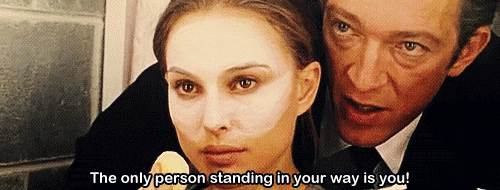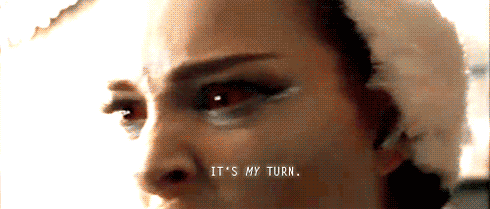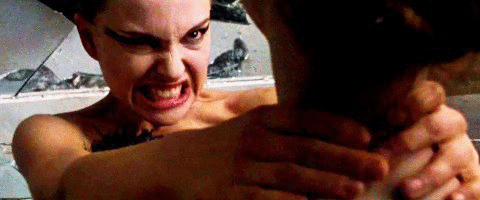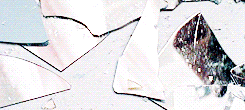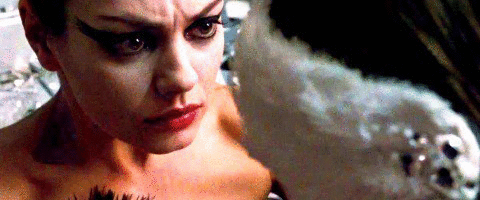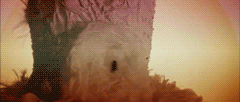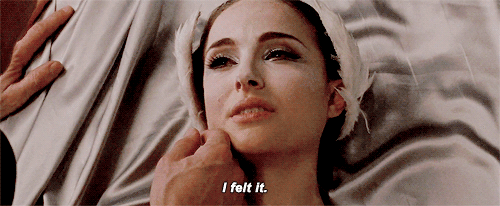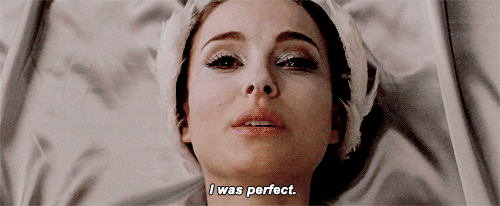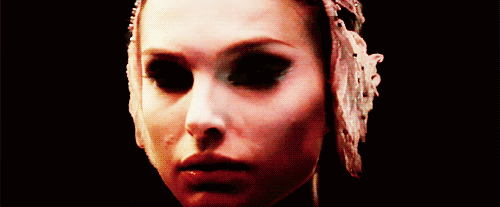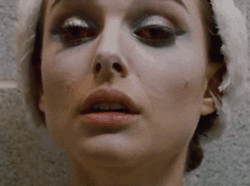“I Just Want to Be Perfect”:
Affective Compulsive Movement in Black Swan
Patricia Pisters
I am struck by the specific affective qualities of film aesthetics in the digital age. While contemporary cinema has moved us deeper into the (often disordered) inner worlds of its characters, at the same time the images (and our engagement with the images) seem to have become more intensely and affectively embodied.
One way of addressing the affective qualities of cinema in the digital age is by pointing out the diffused embodiment of actors’ bodies that morph and modulate with digital codes into malleable bodies, resonating with the contemporary logic of the optimization and transformability of the body through plastic surgery and other body modifications that have become an important dimension of contemporary normative physicality. Both Steven Shaviro and Steen Christiansen have convincingly argued how digital morphing and modulations of the actor’s body both express and allow the audience to experience the affective intensities of the “forces and intensities we are subjected to” and to understand how normative “biopower feels.”[1]
In my observations here, I would like to draw attention to another form of digital aesthetics that is connected to a post-cinematic affect, namely the compulsive looping qualities of GIFs. The Graphic Interchange Format, introduced in 1987 by Compuserve, is a format to compress digital images that allows simple animations that repeat in endless loops. It is a popular form of engagement with cinema online; everywhere on the web one can find countless and endless looping combinations of homemade animations from movie stills.[2] While the GIF images themselves are in fact truly post-cinematic, in that this aesthetic form belongs to the extra-filmic online media landscape, I would like to reconnect these fascinating and obsessively repetitive images to a particular compulsiveness in contemporary film aesthetics that expresses an embodied brain world.
Black Swan (Aronofsky, 2010) shows us typical affective qualities of the mental world of its heroine.[3] Nina Sayers (Nathalie Portman) is a ballerina at a New York ballet company, whose desire to dance becomes an obsessive compulsion.
The compulsion to dance is a familiar theme in popular culture and in cinema, and so before looking at the specific post-cinematic qualities as compulsive disorderly, it might be useful to briefly return to a classic reference. In Powell and Pressburger’s The Red Shoes (1948) we find another heroine who cannot stop dancing.[4] Here we find another ballerina, Vicky Page (Moira Shearer), who joins a company led by an ambitious impresario, Boris Lermontov (Anton Walbrook). In this film, too, as the reference to Hans Christian Andersen’s nineteenth century fairy tale already indicates, the dancer cannot stop dancing and is controlled by the red shoes. A comparison between these two moving and dancing bodies on screen will reveal an affective difference in which the spectator is moved and engaged in new ways. In both cases the story as well as the film aesthetics have to be contextualized in their respective worldly surroundings.
Let me first move to 1948, when The Red Shoes came out. Besides the references to Andersen’s fairy tale, the film draws on Sergei Diaghilev’s legendary Ballets Russes and his dancers, especially Vaslav Nijinksy. Much has been written about the genesis and the highly acclaimed artistic qualities of the film that now exists in a beautifully restored version on DVD in the Criterion Collection.[5] The film is a true manifesto for art and in that sense has to be seen in the context of a gloomy post-war Britain. In his memoir, A Life in Movies, Powell would later explain: “We had all been told for ten years to go out and die for freedom and democracy… and now the war was over, The Red Shoes told us to go out and die for art.”[6] The film opens with a hungry-for-art crowd of students storming into the Covent Garden Opera house to see a Lermontov ballet. And then we move into the backstage story that shows audiences the magic of art and the sacrifices it involves.
Lermontov demands everything of his dancers and gets obsessed by the young, ambitious Vicky Page, who lives for dancing. He also hires a young composer, Julian Craster (Marius Goring), who composes “The Red Shoes,” a ballet that is performed in its full seventeen-minute length in the film. With this ballet we move from the backstage story, that we can follow as spectators from the outside, into Vicky’s mental world. The entire ballet is like a dream sequence that expresses the fears and inner struggle of the heroine, in splendid Technicolor and fantastic surreal sequences.
With purely cinematographic means we see how she slips magically into the red shoes, and how the shoes move her through her inner landscape, where she dances with newspapers and encounters the shadows of Lermontov, Julian and the shoe seller, that install fear in her. As spectators we witness this long dance sequence as the narrative foreshadowing of the struggle to come. Vicky will have to choose between art and life. While enjoying the beautiful movements and colorful mise-en-scene, we feel for her.
The company successfully travels through Europe but Lermontov cannot accept anything else but artistic endeavor and, when Vicky and Julian fall in love, this is the end of their career at the Lermontov ballet. At the end of the film Vicky returns one more time to dance “The Red Shoes.” But here the shoes really take possession of her and carry her outside where she throws herself off a bridge.
The Red Shoes embodies a desire for artistic creation and displays the sacrifices true art involves. It’s a display for us, for the spectator who, after the grim grey war years, could connect this to a collective desire for color and the magic of art. The ballet sequence that expresses the inner world of the character, her desires and fears, is clearly separated from the backstage story. Fantasy and reality remain separated; art itself is a separate world that exists through the sacrifices of its creators. The compulsion to dance, compressed in the vivid red of the red shoes, stands in this way for a collective desire for beauty and art, even if true art comes with a price.
Things are quite different, more confusing and more intimately fearful, in Darren Aronofsky’s more recent ballet film, Black Swan. Again we have here a very well-known nineteenth-century cultural reference, the story of the white and black swan of Tchaikovsky’s Swan Lake, displaced onto the ballet world of contemporary New York. And while there are no red shoes in Black Swan, the compulsion to dance is no less and has turned all the more inward, to the point of mental disorder.
As I will suggest, just like the trauma of the Second World War was part of the collective subconscious engrained in The Red Shoes and post-war cinema more generally, in contemporary cinema of the twenty-first century, we see characters suffer from the “psychopathologies of cognitive capitalism.”[7] Of course, this demands a deeper development than I can give here by only referring to Black Swan and the kind of compulsive movements and thoughts we encounter in cinema (and in the world) today.[8]
The setting of Aronofsky’s film is contemporary New York City, with its own specific challenges of hyper-crowdedness and hyper-individualism where everyone is connected to their own displays, surrounded by a sea of urban screens. In this world we encounter Nina training at a highly competitive ballet school where everyone dreams of becoming the Swan Queen. It’s a world full of ambition and drive, loneliness and insecurity. And of endless practicing and perfecting.
Also at home Nina cannot stop practicing her fouetté turns. Her dominant mother (who once gave up her own ballet career when she got pregnant) does nothing to keep her daughter in balance. On the contrary, she feeds her on only a poached egg and half a grapefruit, feeding her obsession even more and watching over her like a small child. The need to be perfect and the development of Nina’s eating disorder can be analyzed in relation to the mother-daughter bond that Nina needs to unshackle during the course of the film. This is a familiar narrative and psychoanalytic pattern that is certainly part of the affective dimensions of the film.
Nina starts to see doubles and this, for Freud, is an archetypical figure of the uncanny.[9] Nina’s struggle between Tchaikovsky’s white and black swan, between good and bad, can certainly be seen in this light.
But the situation is even more complicated, and this becomes clear because, as spectators, we find ourselves actually, during the entire film, inside Nina’s head. At least that is what we slowly but surely discover. Nina’s doubles multiply: her mother (Barbara Hershey), Beth (Winona Ryder), the older ballerina who loses the leading role, and especially Lily (Mila Kunis), a colleague performer at the ballet who seems more at ease in the world; everywhere Nina sees herself in a mirror face, to the point where the mirror starts to speak back and the border between reality and hallucination starts to dissolve. And is that rash real or not; is she growing wings perhaps?
Gradually we are drawn deeper into Nina’s psycho-pathological world of borderline personality disorder, obsessive compulsions, anorexia and psychotic episodes. We experience the world with Nina, from within her subjective experiences and perceptions that become increasingly unreliable. However, rather than a precise clinical diagnosis, it is important to note the emergence of these types of affective aesthetics of “mental disorders” everywhere in contemporary cinema.[10] This internal aesthetics has several characteristics. First of all the character’s mental disorder or brain disease has to be seen not just in relation to individual situations, individual minds or brain conditions, but as related to the cultural and the social, to the world.
And our contemporary world is no longer a shattered postwar Europe with an escapist longing for color and art, but an overloaded, globalized urbanized mediatized world, where only the winner counts and good is never good enough.
The choreographer of the Swan Lake, Thomas Leroy (Vincent Cassel), challenges Nina to let go of her docile controlling white swan ego in order to unleash the seductive powers of the black swan. In contrast to Lermontov in The Red Shoes, Leroy emphasizes not so much the mystery and magic of art, but points out the doubles in Nina’s psyche: “The only person standing in your way is you,” he tells her.
Again we see the familiar white versus black swan here, but again put in a different psychological perspective, and via Nina in a different collective psychology of the twenty-first century brain and data doubles, in which we are constantly invited to become the best versions of ourselves, always striving for more perfection: tracking ourselves, counting our steps, improving our quantified selves, checking our profile, developing a “CEO brain,” or making the best selfie, distributed in the most effective way, becoming Me 2.0, 3.0.
In this world Nina wants to control, to be the perfect Swan Queen, white and black. On the advice of Leroy to let the more uncontrolled black swan out, she goes with Lily to a club where Lily offers Nina xtc “to relax”. Here Nina has both a breakthrough (disobeying her mother for the first time ever) and breakdown (discovering she is no longer able to trust her brain). As spectators, we are now completely drawn into the reality of Nina’s hallucinations.
Here we find a second characteristic of the affective aesthetics of cinema in the digital age. Because we are drawn into these “disordered” brain worlds and mental landscapes, it becomes increasingly difficult to distinguish between the actual and the virtual, the real and the imagined, the screen, the mirror and reality. Again this is not just in the film but closely resonating with our own contemporary situation.
Meanwhile, in Black Swan Nina has obtained the role of swan queen. And so the day arrives she performs the Swan Lake, in which she completely loses herself. After a misstep as white swan, she returns to her dressing room where she finds Lily in her black swan costume. She kills her rival.
And then, finally, she can perform the black swan herself, to the point where she feels she is becoming-swan, affectively rendered not only in the dancing movements of her dancing arms that feel like wings, but rendered cinematographically with morphing technology that merges the body of the dancer with the body of the swan.
On an affective level, Nina transcends her human body, enters into an affective and intensive zone where she becomes the black swan.
Transformed back into white swan, she (and we as audience) discover that she is wounded. By attacking her rival double, she had attacked herself.
And so she dies, too… But not in despair, torn between art and life, torn between two loves—as Vicky in The Red Shoes but in peace, having felt the perfection that she was striving for, but paying the price of having lost her mind.
In Black Swan we have again the idea of art to die for, but I hope to have been able to suggest that there are important differences in the compulsive movements and affective aesthetics in both films. Here we see a dancer very much connected to the collective madness of the contemporary media world. Nina’s obsession and compulsion to dance is related to a very individualized expression of striving for ever greater perfection under the pressures of a globalized, urbanized, highly competitive world. Importantly, Black Swan as a film takes us into the mental world of its main character, in a way that it becomes much harder to distinguish between the actual and the virtual, the real and the imagined.
The Red Shoes is a backstage story, opening the doors ‘behind the scenes’ to an otherwise separated world of art and entertainment (and the sacrifices it involves), and the ballet performance of “The Red Shoes” is a clearly defined moment in the film where the ballet is expressing the fears of the character, using all the available techniques possible at that time (Jack Cardiff’s splendid camera work, the narrative foreshadowing in the ballet to prepare us for the rest of the story, the fantastic color splashes of the Technicolor cinematography). And so the film translated something of a collective desire for art and beauty at the time. The dancer in The Red Shoes performs for us.
In Black Swan, the borders between stage performance and life, between reality and illusion (hallucination), are much less clear, not only for the character but certainly also for the audience, who live in a world in which these borders equally have become less defined. In Black Swan the dancing heroine is in a relation of becoming to us, where we enter into similar kinds of affective compulsions. The over-abundance of images, information and screens in our globalized world, combined with an ever-growing demand on each individual to become the best version of oneself in a highly competitive world where only the winner counts, is a pressure the contemporary audience can recognize across many different fields and disciplines. Nina’s compulsive obsessiveness is therefore connected to a particular mindset of our times.
Black Swan is not just a film about the ballet world; it is a film about our world, where the brain has become a concern of us all. And where we all have to find ways to find the shifting border between breakthrough and breakdown, between ambition and obsession.
By using the looping technologies of our digital tools, in the animations inserted here, I hope the affective repetitions of the compulsive movements of our times can be felt as the “affective relationship among bodies and film technologies,” as Lisa Cartwright called the psychic interaction offered in rotoscope animation film.[11] Like rotoscope animation, the animation of the human body in a compulsive technology such as a DIY digital animation (GIF) is performative and expressive and resonates with the appropriation of disorderly affective movements that pass between the film and the audience in such a way that it becomes increasingly harder to tell where cinema and life are affectively still separated.
Patricia Pisters is professor of film at the Department of Media Studies of the University of Amsterdam and director of the Amsterdam School of Cultural Analysis (ASCA). She is one of the founding editors of the Open Access journal Necsus: European Journal of Media Studies and the author of The Neuro-Image: A Film-Philosophy of Digital Screen Culture (Stanford University Press). See for other publications, her blog and audio-visual essays www.patriciapisters.com
Notes
[1] Steen Christiansen, “Metamorphosis and Modulation: Darren Aronofsky’s Black Swan,” in Post-Cinema: Theorizing 21st-Century Films, eds. Shane Denson and Julia Leyda (Falmer: Reframe Books, 2016), 6. See also Steven Shaviro, Post-Cinematic Affect (London: Zero Books, 2010).
[2] All images are from Black Swan, except figures 3, 4 and 5, which are from The Red Shoes. The GIFs in this article are all from giphy.com
[3] Black Swan, 35 mm and digital film, directed by Darren Aronofsky, USA, 2010.
[4] The Red Shoes, 35 mm film, directed by Michael Powell and Emeric Pressburger, UK, 1948.
[5] See for instance, Ian Christie, Arrows of Desire: The Films of Michael Powell and Emeric Pressburger (London: Waterstone, 1985); Marc Connelly, The Red Shoes: Turner Classic Movies British Film Guide (London: I.B. Taurus, 2005); Adrienne Mc Lean, Dying Swans and Madmen: Ballet, the Body, and Narrative Cinema (New Brunswick: Rutgers University Press, 2008); and David Ehrenstein, “Dancing for your Life.” Essay with Black Swan DVD (New York: The Criterion Collection, 2010), 5-15.
[6] Quoted in Ehrenstein, “Dancing for your Life,” 6.
[7] Arne de Boever and Warren Neidich, eds, The Psychopathologies of Cognitive Capitalism: Part One (Berlin: Archive Books, 2013).
[8] I have developed this argument more fully in Patricia Pisters, The Neuro-Image: A Deleuzian Film-Philosophy for the Digital Age (Stanford: Stanford University Press, 2012).
[9] Tarja Laine, “The Uncanny Sublime: Black Swan,” in Laine, Bodies in Pain: Emotion and the Cinema of Darren Aronofsky (New York and Oxford: Berghahn, 2015), 127-157.
[10] Just to give a few examples, amnesia in Memento and the Bourne trilogy, depression in Anti-Christ and Melancholia, epilepsy in Control and The Butterfly Effect, bi-polarity in Homeland, OCD in Silver Linings Playbook, social anxiety disorder in Mr. Robot, not to mention the countless films that deal with PTSD, such as Stop Loss and American Sniper.
[11] Lisa Cartwright, “The Hands of the Animator: Rotoscopic Projection, Condensation, and Repetition Automatism in the Fleisher Apparatus,” in Body & Society 18 (1), 2012, 47. Cartwright also connects the disorderly movement of animation to Tourette’s syndrome. See her lecture, “Tourettic Animation,” at the Tate Modern in London: http://www.tate.org.uk/context-comment/video/pervasive-animation-day-3-video-recordings and the Global Tourette research project in which she participates http://www.globaltourette.net/.

